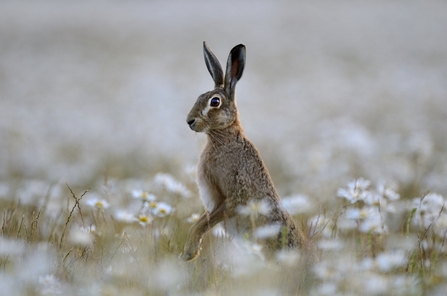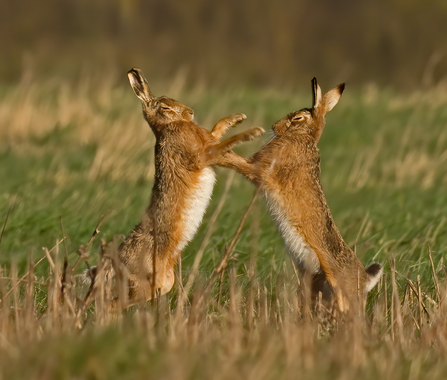Brown hares are much larger than rabbits, have much longer black-tipped ears and long legs, but they also have a quite different stance. A hare in motion rises on its legs, starting to look a bit like a small antelope; when running at full speed it seems to skim over the earth, its feet never touching the ground. Stationary, it stands up tall on its hind legs to see what’s going on around it, then hunches down and seems to vanish, camouflaged against the ground. Hares are largely nocturnal, solitary, and, as they live above ground, leave few visible traces of their lives. No wonder there is a wide mythology attached to them!
Dr Cath's Nature Notes - March 2023
David Tipling/2020Vision

(c) David Tipling 2020 Vision
Their courtship behaviour however is more obvious. Hares are seen to stand up on their hind legs and box each other, and this was thought to be two furious males competing for the favours of a female. In fact, it’s usually a female rebuffing an over-amorous male. Females (jills or does) are only receptive for mating (known as in season, or in oestrus) for a few hours at a time, and outside this period she will be unreceptive to any advances. Male hares (jacks or bucks) are highly promiscuous, and many may be attracted to a female before she comes properly into season, hoping to guard her until mating has taken place, so fights and chases between bucks are also common. Such conspicuous action out in the open seems mad indeed, for a normally shy and secretive creature.
The breeding season for brown hares begins in January and can continue through until August or even later – in mild winters breeding can be almost continuous. This behaviour can therefore be seen at any time of year, but is usually only observed by humans before vegetation has grown high enough to conceal the hares.

Boxing Brown Hares (c) Russell Savory
If you want to see March hares yourself, they are fairly evenly distributed across the county, though more thinly spread in the Shropshire Hills and north-west Shropshire, where the habitat is less suitable.
Ideal habitat is a mosaic of non-intensive open farmland with both arable and pasture and hedges. Numbers have declined nationally by 80% in the last century, due to changes in farming practice, habitat loss and hunting, and the species is of conservation concern.
Many Shropshire Wildlife Trust nature reserves are managed with consideration for hares. Early in the morning or at dusk are good times to watch, but I’ve seen good hare activity after an afternoon thunderstorm too. My best sightings have been in stubble fields or young arable crops – maize seems very popular. You might like to get up early, stake out a suitable field gate overlooking a young crop, and just wait and see what comes along!

